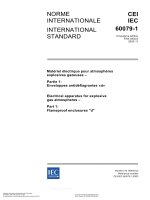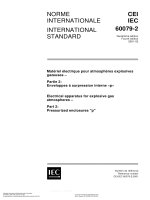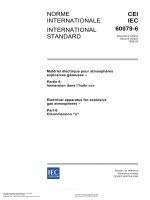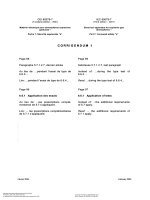Developed for Pacific Gas & Electric Company and Southern California Edison Company potx
Bạn đang xem bản rút gọn của tài liệu. Xem và tải ngay bản đầy đủ của tài liệu tại đây (702.77 KB, 65 trang )
Industrial Sectors Market Characterization
Paper Industry
Developed for Pacific Gas & Electric Company and
Southern California Edison Company
.
Oakland, California, January 2012
Table of Contents
Acronyms and Abbreviations ........................................................................................................ 1
Summary of Findings .................................................................................................................... 1
Industry Description ............................................................................................................... 1
Business Models and Cost Structure ..................................................................................... 1
Technology and Energy Consumption ................................................................................... 2
Market Barriers and Opportunities for Energy Efficiency ....................................................... 3
Overall Findings ..................................................................................................................... 3
1. Introduction ............................................................................................................................ 5
2. Trends in Industrial Energy Efficiency.................................................................................... 7
2.1 Energy Consumption Trends ........................................................................................ 7
2.2 National Programs ........................................................................................................ 9
2.3 Rise of Continual Energy Improvement ...................................................................... 11
2.4 Additional States Adopt Industrial Energy Efficiency .................................................. 13
3. Industry Characterization ..................................................................................................... 16
3.1 Industry Definition ....................................................................................................... 16
3.2 Industry Leaders ......................................................................................................... 19
3.3 Competitive Issues ..................................................................................................... 20
3.3.1 Business Models............................................................................................. 21
3.3.2 Cost Structure ................................................................................................. 22
3.3.3 Technology Development ............................................................................... 24
3.3.4 Supply Chain Management ............................................................................ 24
3.3.5 Value Chain .................................................................................................... 26
3.3.6 Pricing ............................................................................................................. 27
3.4 Economic Factors ....................................................................................................... 28
3.4.1 Business Cycles ............................................................................................. 28
3.4.2 Availability of Capital and Credit ..................................................................... 29
3.5 Regulatory Issues ....................................................................................................... 31
3.6 Industry Network......................................................................................................... 33
3.6.1 Supplier and Trade Allies................................................................................ 34
4. Target Technologies / Processes and Energy Efficiency..................................................... 36
4.1 Energy Use ................................................................................................................. 36
4.2 Production Processes................................................................................................. 37
KEMA, Inc.
i
January 2012
Table of Contents
4.3
4.2.2 Cardboard Manufacturing ............................................................................... 40
Current Practices ........................................................................................................ 40
4.3.1 Efficiency Improvements................................................................................. 44
4.3.2 Barriers to Industrial Energy Efficiency Adoption ............................................ 47
5. Market Intervention .............................................................................................................. 48
5.1 Needs Assessment..................................................................................................... 48
5.2 Key Drivers and Barriers ............................................................................................ 48
5.3 Decision-making Process ........................................................................................... 49
6. Next Steps and Recommendations ..................................................................................... 51
6.1 Implementation ........................................................................................................... 51
6.2 Evaluation ................................................................................................................... 52
7. Bibliography ......................................................................................................................... 53
List of Figures
Figure 1: Graphic Overview of Report .......................................................................................... 6
Figure 2: U.S. Trends in Industrial Energy Intensity Delivered Energy, 1985-2004 ...................... 8
Figure 3: Industrial Technologies Program Funding, 1998-2010 ................................................ 10
Figure 4: Examples of National and Regional Continual Energy Improvement Programs.......... 11
Figure 5: Utility Energy Efficiency Policies and Programs, 2006 vs. 2007+ ................................ 14
Figure 6: Stages of Papermaking ............................................................................................... 39
Figure 7: Electric Consumption, Paper Industry ......................................................................... 41
Figure 8: Electric Consumption by End Use, Paper Industry ...................................................... 41
Figure 9: Electric Energy Efficiency Potential, Paper Industry .................................................... 42
Figure 10: Gas Consumption by End Use .................................................................................. 43
Figure 11: Gas Energy Efficiency Potential, Paper Industry ....................................................... 44
List of Tables
Table 1: Industrial Energy Consumption, California ...................................................................... 8
Table 2: 2020 Cumulative Electricity Savings Targets, by State ................................................ 15
Table 3: Summary of NAICS Code 322 ...................................................................................... 17
KEMA, Inc.
ii
January 2012
Acronyms and Abbreviations
AB32
Assembly Bill 32 the Global Warming Solutions Act
ACEEE
American Council for an Energy Efficient Economy
AMO
Advanced Manufacturing Office
ARB
California Air Resources Board
Btu
British thermal unit
CAA
Clean Air Act
CWA
Clean Water Act
CO2
carbon dioxide
CO2e
carbon-dioxide equivalent
GHG
greenhouse gas
GMP
good manufacturing practices
FDA
Food and Drug Administration
GWh
gigawatt-hour(s)
ESA
Endangered Species Act
kWh
kilowatt-hour
LBNL
Lawrence Berkeley National Laboratory
MBtu
million British thermal unit
NAICS
North American Industry Classification System
O&M
operations and maintenance
PG&E
Pacific Gas and Electric Company
R&D
research and development
RCRA
Resource Conservation and Recovery Act
SCE
Southern California Edison Company
TBtu
trillion British thermal unit
VSD
variable speed drive
U.S.
United States
USGS
U.S. Geological Survey
U.S. EPA
U.S. Environmental Protection Agency
U.S. DOE
U.S. Department of Energy
KEMA, Inc.
1
January 2012
Summary of Findings
Industry Description
Industries categorized under the North American Industry Classification System (NAICS) threedigit prefix of 322: paper manufacturing make pulp, paper, and converted paper products. Paper
Manufacturing is generally subdivided into two industry groups: the first for the manufacturing of
pulp and paper and the second that uses paper inputs to manufacture converted paper
products. Pulp mills, paper mills, and paperboard mills comprise the first industry group.
Establishments that make products from purchased paper and other materials make up the
second industry group. In California, there are no longer any facilities that create pulp from
forest products,1 which is a highly intensive energy process. California is home to over 500
facilities that make paper and wood products, primarily in northern California. These include
paperboard container manufacturing, paper bags and treated paper, stationery products, and
converted paper products such as tissue paper and disposable diapers
There are approximately 4,000 companies that manufacture paper products in the United
States, although the market is dominated by International Paper Co., Kimberly Clark, SmurfitStone, MeadWestvaco, Domtar (which merged with Weyerhauser), Temple-Inland,
AbitibiBowater, Greif Inc., and Packaging Corp of America. Acquisitions, divestitures, and
restructurings have been common over the previous decade in the North American market. The
market consolidation and specialization trend is influenced primarily by the need to stay
profitable in a mature industry characterized by large capital requirements and high barriers to
market entry.
Business Models and Cost Structure
The pulp and paper industry is characterized by large industry leaders and numerous smaller
manufacturing firms. The large players tend to be highly vertically integrated. For example, a
firm may own and manage forestry resources, manufacture pulp, mill paper and cardboard,
manufacture converted paper products, and distribute goods to markets. These companies take
advantage of economies of scale, control over the supply of inputs, and cash resources for
technological research and development. Smaller companies generally do not manufacture their
1
The Center for Paper Business and industry studies, Pulp Mills, Pulp & Paper Mills, Paper Mills in
California, />
KEMA, Inc.
1
January 2012
own inputs and do not have economies of scale in production. These firms are especially
vulnerable to input market volatility, causing many to enter into bankruptcy during periods of
volatile input prices during the mid to late 2000s.
The primary costs for paper converting industries such as cardboard box and food packaging
operations are purchases of input materials. About 60 percent of costs stem from purchasing
market pulp, paperboard, paper, old corrugated containers, adhesives, resins, chemicals, and
other inputs to the manufacturing process. Energy costs are less than 2 percent of revenue.
Recycled fiber costs have also fallen in the recession. Containerboard manufacturers are major
consumers of recycled fiber, with some producers relying on old corrugated containers for more
than half of their fiber supply.
Paper manufacturers have also seen a decrease in capital costs in recent years. Investment in
buildings, machinery and equipment has declined due to global economic slowdown symptoms
such as downsizing of operations, lower returns on investments, and difficulty in securing
financing.
Overall, demand for paper products has been consistently flat or negative based on
fundamental changes in technology, consumer habits, and the anemic economy. The recession
has exacerbated the financial situation of pulp and paper product manufacturers, further
accelerating the trends of industry consolidation, downsizing of workforces, shuttering of
manufacturing plants, and off shoring of production.
Technology and Energy Consumption
The pulp, paper, and converted paper products industries have undergone dramatic changes in
the late 1990s and 2000s due to increased computerization and automation of manufacturing
processes. Production processes for making cardboard have improved resulting in reduced
energy consumption, reductions in chemical use, and increased volume of recycled material
use.
A large amount of research over the past five years has been directed toward reducing energy
consumption, improving environmental performance, and increasing the inclusion of recycled
material in manufacturing. The American Forest and Paper Association initiated the Agenda
2020 Technology Alliance, an industry led partnership with government and academia, meant to
re-invent the forest products industry through innovation in processes, materials, and markets.
KEMA, Inc.
2
January 2012
The supply chain for the paper products industry relies on either internal sources of forest
products (for a vertically integrated company) or market prices of pulp or paper. Hardwood
forests in North America require a longer growth cycle and harvest rotation compared to fast
growing eucalyptus trees in South America. In addition, eucalyptus pulp has lower production
costs due to more favorable labor and energy costs where the trees are grown. These trends
likely mean further shutdowns of North American hardwood pulp capacity.
Market Barriers and Opportunities for Energy Efficiency
The paper industry has been slowing down for the last several years. Due to the consolidations
and facility shutdowns, no pulp mills remain in California, and the primary industry is converted
paper manufacturing. This segment has much lower energy use than the pulp and paper
subsector, is highly cost competitive, and likely less sophisticated regarding energy efficiency
than other industrial subsectors.
Energy efficiency opportunities exist by optimizing existing systems for pumps, motors, air
compressors, dryers and boilers. An applicable emerging technology is magnetically coupled
adjustable speed drives.
Overall Findings
Although California has no pulp mills, multiple potential strategies exist for energy efficiency
programs in the paper segment. Low-cost opportunities are most likely to be accepted.
Given the modest interest in energy efficiency, utilities can design programs to first inform, and
then engage customers into tapping their in efficiency opportunities. The following findings
regarding improving the adoption of energy efficiency measures in the water and wastewater
industry are based on the research presented in this report.
•
Provide industry-specific audits and best practices. Custom efficiency programs work
well with basic manufacturing sectors like converted paper products. The primary
research noted customers preferred utility-sponsored audits. Additionally, the utilities can
work with this segment to understand their maintenance and upgrade needs over the
next 10 years. These are the best times to upgrade to efficient equipment.
•
Engage the uninterested in measurement. One of the biggest challenges in the industrial
sector is getting participation. One opportunity for engaging the less interested
customers is to focus on the measurement of their utility use, and assist them in
KEMA, Inc.
3
January 2012
breaking down their bill to specific operations. This can then highlight energy efficiency
opportunities.
•
Design innovative pilots to address a range of needs. Programs that focus on short-term
gains, low-cost or no-cost options such as predictive maintenance, and behavior are
appropriate.
•
Identify Planned Upgrades and Document Associated Efficiency Opportunities.
Companies will continue to invest in plants where long-term markets are perceived.
Major upgrades may be infrequent, possibly only every 10 years. As utilities are aware of
the customers’ long-term plans, they can encourage the addition of energy efficiency.
Early and complete documentation of the utility’s involvement will assist in appropriate
net-to-gross evaluations for energy efficiency projects.
KEMA, Inc.
4
January 2012
1.
Introduction
The industrial sector consumes over 30 percent of the nation’s energy,2 presenting enormous
opportunities for energy efficiency.3 Many market forces beyond simple energy cost drive
industrial customer decision making. Attaining a better understanding of the customer’s world
will assist Pacific Gas and Electric Company (PG&E) and Southern California Edison (SCE) in
their design and implementation of industrial energy efficiency programs. Following upon a
potential study developed in 2009 for PG&E, PG&E and SCE engaged energy-consulting firm
KEMA, Inc. for the next phase to prepare market intelligence on seven key energy-intensive
sub-segments.
The research objective is give PG&E and SCE staff study results to facilitate improved
marketing of energy efficiency products and support face-to-face engagement of customers with
those products. To address the objective of this study, the work was organized into key
elements. These include:
•
•
Perspectives about broad trends affecting California and the nation’s industrial sectors
(section 2)
Detailed in-depth, industry-specific analysis of business and process drivers developed
from secondary research (section 3)
Energy usage, target technologies and process, and energy efficiency opportunities
(section 4)
Real-time perspectives and intelligence gained from key industry insiders through
•
interviews and Webinar/Forum group discussions (section 5)
Recommendations (section 6).
•
•
In practice, these report elements are built stepwise--broad national trends inform industryspecific secondary research and industry-specific analysis informs the primary interviews and
roundtable discussions. The outcome is a thorough research report intended to provide PG&E
2
Quinn, Jim. 2009. Introduction to the Industrial Technologies Program. Save Energy Now Series
Webinar. January 15.
/>3
U.S. Census Bureau, 2008.
/>
KEMA, Inc.
5
January 2012
and SCE staff members the breadth necessary to position their industrial energy efficiency
products optimally and the depth necessary to knowledgeably engage their customers.
Figure 1: Graphic Overview of Report
KEMA, Inc.
6
January 2012
2.
Trends in Industrial Energy Efficiency
The industrial sector consumes an immense amount of energy, nearly 32 percent of total U.S.
consumption in 2008,4 to produce goods and materials for wholesale and retail sales. In the
past three decades, the overall energy efficiency of the industrial sector in the U.S. has
increased dramatically. Energy efficiency potential savings nationally have been estimated at 20
percent or more by 2020.5 It has thus been an attractive target sector for utilities and
government looking to reach new levels of energy savings through efficiency.
Changing energy markets and climate change policies are driving greater interest in energy
efficiency technologies. Key trends discussed are energy consumption patterns; effect of the
economic downturn on manufacturing; climate change and energy legislation; the rise of
continuous energy improvement; energy efficiency adoption outside California and national
energy efficiency programs; opportunities for combined heat and power. These trends are
discussed in more detail below.
2.1
Energy Consumption Trends
California ranked first in the nation in gross domestic product, at $1891.4 billion in 2009. Table 1
shows the industrial energy consumption. California ranks only third in the nation for energy
use, reflecting higher efficiency levels in the industrial sector.6
Figure 2 shows U.S trends in industrial energy intensity over time. This figure shows that there
has been a general trend since 1993 toward stable or slightly decreasing energy use, even
while the economy prospered. More significantly, the energy intensity, or energy per unit of
production, has been steadily increasing. Thus, the industrial sector has shown consistent
improvement in reducing the amount of energy required to produce manufactured goods.
4
U.S. Census Bureau, 2008. Energy Consumption, by End-Use Sector.
/>5
McKinsey & Co. 2009. Unlocking Energy Efficiency in the U.S. Economy. July.
/>mary.PDF
6
U.S. Department of Energy, Energy Efficiency and Renewable Energy, State and Regional
Partnerships. 2011. />
KEMA, Inc.
7
January 2012
Table 1: Industrial Energy Consumption, California
Year
2009
2008
2007
2006
2005
2004
2003
2002
2001
2000
California Industrial Energy
Consumption
(Trillion Btu)
1,770
1,955
1,958
1,979
2,001
2,053
1,986
1,999
2,137
2,132
Source: Energy Information Administration7
Figure 2: U.S. Trends in Industrial Energy Intensity Delivered Energy, 1985-2004
Source: National Academy of Sciences8
7
U.S.DOE. 2011. State Energy Consumption Estimates 1960 through 2009. DOE/EIA-0214(2009). June
2011.
http://205.254.135.7/state/seds/sep_use/notes/use_print2009.PDF
KEMA, Inc.
8
January 2012
2.2
National Programs
Typical utility programs address only a subset of the energy efficiency improvement
opportunities, focusing primarily on retrofits and capital improvements. Less attention is given to
behavior or maintenance. Federal, regional, and state government agencies, utilities, and others
have developed a range of programs to improve industrial energy efficiency. These include
providing incentives, audits and technical assistance, and continuous improvement programs.
Many of PG&E and SCE’s customers participate in these programs, which can yield insights
and best practices to inform utility programs, such as energy assessments offered by the U.S.
DOE’s Advanced Manufacturing Office (AMO), formerly the Industrial Technologies Program. In
California, 49 assessments were completed for small and medium facilities in 2009 through
2011 and 38 assessments for large facilities between 2006 and 2011.9
The U.S. DOE’s AMO has been the primary federal entity supporting manufacturing R&D in
partnership with industrial stakeholders. The AMO R&D program has been recognized as one
of the most successful federal R&D efforts operating today. However, in recent years support for
the program’s R&D funding has faltered, particularly for the industry-specific R&D funding. This
has been the most effectual initiative, considering its track record of commercializing products
useful to industry. A U.S. DOE peer review report called the manufacturing R&D pipeline
“largely empty.”10 This is challenging for the transformation of manufacturing because even
though AMO's industry-specific R&D reaches commercialization faster than most other federal
R&D, it can still take seven to ten years for results from R&D to reach a plant floor.
In addition to R&D activities (both the industry specific mentioned above and cross cutting),
AMO has two technology and best practices programs: Better Plants (formerly Save Energy
Now) and the Industrial Assessment Centers.
8
National Academy of Sciences. 2010. Real Prospects for Energy Efficiency in the United States.
National Academies Press.
U.S. Department of Energy, Energy Efficiency and Renewable Energy, State and Regional Partnerships.
2011.
/>9
10
ACEEE 2009. Barriers to energy efficiency investments and energy management in the U.S. industrial
sector. />
KEMA, Inc.
9
January 2012
Figure 3: Industrial Technologies Program Funding, 1998-2010
Source: ACEEE11
Better Plants works with large industrial energy consumers to help reduce their energy intensity
using audits, software tools, and best practices. The other program, Industrial Assessment
Center (IAC), serves a similar function for small- and mid-sized industrial facilities, and also
trains the next generation of industrial energy engineers. Twenty-six centers at U.S. engineering
universities train students to identify energy savings opportunities and perform no-cost
assessments for small and medium industrial customers. In California, the San Francisco State
University and San Diego State University run IAC programs. The IAC program has a public
database of recommendations dating back to 1981, a resource for customers on industrial
energy efficiency improvements.
11
American Council for an Energy Efficient Economy. 2009. Barriers to energy efficiency investments
and energy management in the U.S. industrial sector. October 20, 2009.
KEMA, Inc.
10
January 2012
2.3
Rise of Continual Energy Improvement
Utilities, and private organizations, and governments around the world have developed
programs in the last few years that focus on setting goals and targets to achieve continuous
energy improvement (CEI) in industry. National programs in the U.S. have been developed by
DOE (Save Energy Now and Superior Energy Performance) and EPA (ENERGY STAR). Figure
4 displays some examples of national and regional continual energy programs. From a business
perspective, interest in energy management is increasing, as shown by the increasing number
of participants in these programs.
Figure 4: Examples of National and Regional Continual Energy Improvement Programs
Two important developments in 2011 are expected to heighten interest and activity around
energy management: the release of ISO 50001, a global energy management standard, and the
launch of superior energy performance, a national program to support energy intensity
reductions for industrial plants and commercial buildings.12
12
McKane, Aimee, Lawrence Berkeley Laboratory, 2011. Presentation at the ACEEE Market
Transformation Conference, Piloting Energy Management Standards for the U.S and the Globe.
/>
KEMA, Inc.
11
January 2012
The recent work on U.S. and international energy management standards will have a significant
impact on how energy is used in the industrial sector. The International Standards Organization
(ISO released an international energy management standard, ISO-50001 in June 2011.
The U.S. Department of Energy is in the process of launching the Superior Energy Performance
(SEP) program to promote industrial energy management and increased energy efficiency. This
voluntary program will focus on fostering an organizational culture of energy efficiency
improvement in U.S. manufacturing facilities, targeting mid- to large-sized plants.
Participants establish an energy management system that complies with ISO 50001 and meets
other SEP program requirements, including robust measurement and verification of energy
savings. Pilot programs have been launched in Texas and the Pacific Northwest, and the full
SEP program is expected to begin in 2013. A California pilot is also planned within the next two
years. The American National Standards Institute (ANSI) is developing companion standards to
support SEP. ANSI MSE 50021 will provide the additional energy performance and
management system requirements for SEP certification that goes beyond basic conformance
with ISO 5000; and ANSI 50028 will provide the requirements for verification bodies for use in
accreditation or other forms of recognition.13
Regional CEI programs have been developed under the Northwest Energy Efficiency Alliance,14
working with the Bonneville Power Administration and the Energy Trust of Oregon. California
has identified CEI as an important aspect of its strategic plan.15 Similarly, Wisconsin’s Focus on
Energy employs an internally developed tool called Practical Energy Management©.16 CEI is still
in its infancy, with few CEI programs beyond the pilot stage.
13
U. S. Council for Energy-Efficient Manufacturing 2010. Superior Energy Performance.
/>14
Northwest Energy Efficiency Alliance. Continuous Improvement for Industry website.
/>
15
California Public Utilities Commission. 2011. CA Energy Efficiency Strategic Plan, January 2011
Update. />
16
Wisconsin Focus on Energy, Industrial Program. Practical Energy Management tool.
/>
KEMA, Inc.
12
January 2012
2.4
Additional States Adopt Industrial Energy Efficiency
California has long been perceived as a leader in energy efficiency programs. Historically,
energy efficiency trends and best practices tended to spread from California to other states
involved in industrial energy efficiency. More recently, a sizable contingent of states have made
significant commitments to energy efficiency programming as shown in Figure 5. The flow of
information is changing as energy efficiency programs spread to locations in the Midwest and
South that typically had provided modest or little ratepayer funding for energy efficiency.
Program development efforts in many of the aforementioned states are in their early stages
compared to California.
These states have signaled their commitment to energy efficiency by adopting aggressive
Energy Efficiency Portfolio Standards17 (EEPS) policies18 that exceed those in California. As
shown in Table 2, California ranks number 14 for cumulative electricity savings targets by 2020,
below states primarily in the Northeast and Midwest.
17
Covers all sectors including residential, commercial and industrial efficiency.
18
These include: Illinois, Maryland, Michigan, New Mexico, Ohio, Pennsylvania, and Virginia
(provisionally).
KEMA, Inc.
13
January 2012
Figure 5: Utility Energy Efficiency Policies and Programs, 2006 vs. 2007+
Source: ACEEE19
The electric EEPS targets in most of these states rise from 1 to 2 percent of retail sales per year
within the first 5–10 years of the standard, rivaling the annual savings levels currently being
achieved in only a handful of leading states. For example, North Carolina has until recently been
relatively inactive in energy efficiency, but has enacted a Renewable Portfolio Standard (RPS).
Under this RPS, energy efficiency can meet up to 40 percent of the total requirements of the
state’s investor-owned utilities (IOUs) and an unlimited amount of the publicly owned utilities’
requirements.
The rise of energy efficiency policies and programs indicates that California utilities can
increasingly draw on program experience in other states to inform their own experiences.
19
, Nadel, Steven. 2011. Program Introduction. (Presentation, ACEEE 2011 National Symposium on
Market Transformation, Washington DC, April 10–12, Conference 2011).
/>
KEMA, Inc.
14
January 2012
Table 2: 2020 Cumulative Electricity Savings Targets, by State20
State
2020 EE Target
State
2020 EE Target
Vermont
30%
Indiana
14%
New York
26%
Rhode Island
14%
Massachusetts
26%
Hawaii
14%
Maryland
25%
California
13%
Delaware
25%
Ohio
12%
Illinois
18%
Colorado
12%
Connecticut
18%
Utah
11%
Minnesota
17%
Michigan
11%
Iowa
16%
Pennsylvania
10%
Arizona
15%
Washington
10%
Source: ACEEE
20
21
Includes extensions to 2020 at savings rates that have been established.
21
Nadel, Steven. 2011. Program Introduction. (Presentation, ACEEE 2011 National Symposium on
Market Transformation, Washington DC, April 10–12, 2011).
/>
KEMA, Inc.
15
January 2012
3.
Industry Characterization
3.1
Industry Definition
Industries categorized under the NAICS three-digit prefix of 322: paper manufacturing make
pulp, paper, and converted paper products. In 2006, the U.S. pulp and paper industry generated
nearly $79 billion in product shipments or around 1.6 percent of the total value of the product
shipments of the U.S. manufacturing sector.22
Paper manufacturing is generally subdivided into two industry groups, the first for the
manufacturing of pulp and paper and the second that uses paper inputs to manufacture
converted paper products. Pulp mills, paper mills, and paperboard mills comprise the first
industry group. Establishments that make products from purchased paper and other materials
make up the second industry group.
These include:
•
•
•
•
Paperboard container manufacturing uses corrugating, cutting, and shaping
machinery to form paperboard into containers.
Paper bag and coated and treated paper manufacturing establishments cut and coat
paper and foil.
Stationery product manufacturing establishments make a variety of paper products
used for writing, filing, and similar applications.
Other converted paper product manufacturing includes, in particular, the conversion
of sanitary paper stock into such things as tissue paper and disposable diapers.
Table 3 below provides the primary NAICS codes for the pulp and paper market segment.
22
Lawrence Berkeley National Laboratory. 2009. Energy Efficiency Improvement and Cost Saving
Opportunities for the Pulp and Paper Industry: An ENERGY STAR® Guide for Energy and Plant
Managers. Prepared for the U.S. EPA. LBNL-2268E. October 2009.
/>
KEMA, Inc.
16
January 2012
Table 3: Summary of NAICS Code 322
322100
Industry Group: Pulp, Paper, and Paperboard Mills
322110
Pulp Mills
322120
Paper Mills
322130
Paperboard Mills
322200
Industry Group: Converted Paper Product Manufacturing
322210
Paperboard Container Manufacturing
322211
Corrugated and Solid Fiber Box Manufacturing
322212
Folding Paperboard Box Manufacturing
322213
Setup Paperboard Box Manufacturing
322214
Fiber Can, Tube, Drum, and Similar Products Manufacturing
322215
Non-folding Sanitary Food Container Manufacturing
322221
Coated and Laminated Packaging Paper and Plastics Film
Manufacturing
322222
Coated and Laminated Paper Manufacturing
322224
Uncoated Paper and Multiwall Bag Manufacturing
322231
Die-cut Paper and Paperboard Office Supplies Manufacturing
322232
Envelope Manufacturing
322233
Stationery, Tablet, and Related Product Manufacturing
322299
All Other Converted Paper Product Manufacturing
In California, there are no longer any facilities that create pulp from forest products, which is a
highly intensive energy process.23 In California, there are over 450 paper manufacturing
facilities, nearly all of which are converted paper products. A few paper and paperboard mills
remain.24 The majority of California mills are in northern California.25
23
Georgia Technical University, Center for Paper Business and Industry Studies. 2011. Pulp Mills, Pulp
and Paper Mills, Paper Mills in California.
/>24
American Forest & Paper Association. 2011. Forest and Paper industry at a Glance, California. June
2011.
/>
25
Georgia Technical University, Center for Paper Business and Industry Studies. 2011. Pulp Mills, Pulp
and Paper Mills, Paper Mills in California.
/>
KEMA, Inc.
17
January 2012
The primary products manufactured in this segment include the following:
•
•
•
•
•
Pulp is the raw material used to make all paper products. Pulp is made by separating
wood fibers from a substance called lignin, which acts as a glue holding the fibers
together. Pulp is often bleached to prepare it for end use. In most cases, a mixture of
different kinds of pulp is prepared to create the specific characteristics of the paper or
paperboard into which it will be processed. This is a highly energy intensive process.
Much less energy is needed to make pulp from recycled paper. California no longer has
any pulp manufacturing.
The printing and writing paper market consists of uncoated and coated paper.
Uncoated paper is used for publishing, writing, and business applications such as
photocopying, computer printing, and envelopes. Lower grade uncoated paper is used
for products such as preprinted newspaper inserts, paperback books, and telephone
directories. Coated paper is used principally for magazines, catalogs, and other
publications that require colored inks.
Newsprint is the thin paper used for daily newspapers. It is generally made with a
majority of mechanical pulp and may include some chemical pulp. In 2007, newsprint
represented 12 percent of total paper production. Its market share has been steadily
declining, as newspapers are increasingly read online.
Products in the paperboard area are divided between containerboard and boxboard. In
recent years, these products have accounted for slightly more than half of the national
industry’s total paper and paperboard production.
– Containerboard is the material used to make corrugated containers for packaging
applications. Containerboard is made of two kinds of paperboard: linerboard and
corrugating medium. Linerboard is the material used on the inside and outside of
corrugated boxes. Corrugating medium is the fluting material comprising the middle
portion of corrugated containerboard. Containerboard materials are made from both
virgin and recycled fibers.
– Boxboard is used to make folding packaging for food, toiletries, cosmetics,
pharmaceuticals, milk, and other products. Boxboard includes solid bleached sulfate
board (the premium grade used in folding cartons), unbleached Kraft boxboard, and
recycled boxboard.
Tissue paper is used in sanitary products such as bath tissue, paper towels, facial
tissue, and napkins.
KEMA, Inc.
18
January 2012
Printing and writing paper, wrapping and packaging paper, and paperboard accounted for 80
percent of total U.S. production by mass in 2006. The remaining production was newsprint,
household and sanitary paper, and all other miscellaneous paper and paperboard.26
3.2
Industry Leaders
There are approximately 4,000 companies that manufacture paper products in the United States
although the market is dominated by International Paper Co., Kimberly Clark, Weyerhaeuser,
Smurfit-Stone, MeadWestvaco, Domtar, Temple-Inland, AbitibiBowater, Greif Inc., and
Packaging Corp of America. Acquisitions, divestitures, and restructurings have been common
over the previous decade in the North American market. Between 1997 and 2002, at least 12
important mergers occurred with a combined value of around $55 billion.27 The market
consolidation and specialization trend is influenced primarily by the need to stay profitable in a
mature industry characterized by large capital requirements and high barriers to market entry.
International Paper is the largest pulp and paper company in the world with manufacturing
operations in North America, Europe, Latin America, Russia, Asia and North Africa.
Headquartered in Memphis, Tennessee, the company employs over 60,000 people in more than
20 countries.28 Its businesses include uncoated papers and industrial and consumer packaging
distributed by Xpedx, the company's North American distribution company. In 2005 and 2006,
International Paper underwent significant restructuring, selling over 6,000,000 acres (24,000
km2) of forestland in the United States, along with its coated paper, kraft paper, wood products,
and beverage packaging businesses, as well as selling subsidiaries Arizona Chemical and New
Zealand-based Carter Holt Harvey.29 In 2008, International Paper bought Weyerhaeuser’s
containerboard, packaging, and recycling business. The deal more than doubled International
Paper’s North American containerboard capacity and made it the world’s largest producer of
containerboard and corrugating medium.
26
Lawrence Berkeley National Laboratory. 2009. Energy Efficiency Improvement and Cost Saving
Opportunities for the Pulp and Paper Industry: An ENERGY STAR® Guide for Energy and Plant
Managers. Prepared for the U.S. EPA. LBNL-2268E. October 2009.
/>
27
Ibid.
28
International Paper website.
29
Data Monitor. 2009. Global Paper Products: Industry Report. Reference code: 0199-2123. March 2009.
/>
KEMA, Inc.
19
January 2012
In 2007, Weyerhaeuser merged with Domtar Corp. This merger combined the second- and
third-largest North American producers of uncoated free-sheet paper, making Domtar the
leading producer in North America, with a share of more than 30 percent.30
Also in 2007, Abitibi-Consolidated Inc. and Bowater Inc., merged to become the world’s largest
producer of newsprint. The new company, called AbitibiBowater Inc., has about a 47 percent
share of the North American newsprint market and a 17 percent share of the global market.
However, demand for newsprint has been in a steady decline, and both of these highly
leveraged companies struggled to turn a profit over the past three years. In April 2009,
AbitibiBowater filed for bankruptcy protection. AbitibiBowater is rebranding as Resolute Forest
Products.31
3.3
Competitive Issues
The pulp and paper industry is characterized by high competition between the large industry
leaders. The pulp and paper industry has a large number of buyers since paper products are
used nearly universally, especially in the food processing, newspaper, and office supplies
industries. Most pulp and paper products are commodities with only small differences between
products from different companies. Therefore, price rather than brand is the primary
consideration in buyers’ decision making. Other product differentiators are quality, durability,
and environmental considerations. The market does have space for smaller manufacturers to
operate in niche markets in higher quality specialty products.
The cardboard box and food container manufacturing sub-segments of the industry are not
highly concentrated as the four largest companies hold only one third of the total market share.
International Paper is the largest player with 15 percent of industry revenue. These are the bulk
of the California operations. The low level of concentration gives no particular firm significant
market power, and creates a highly competitive environment in the industry. Also, approximately
half of all the industry products sold are generic cardboard boxes that are difficult to differentiate
between manufacturers.
30
Ibid.
31
Marotte, Bertand. 2011. “AbitibiBowater: From behemoth to lean and green.” The Globe and Mail. Dec
26, 2011.
/>
KEMA, Inc.
20
January 2012









